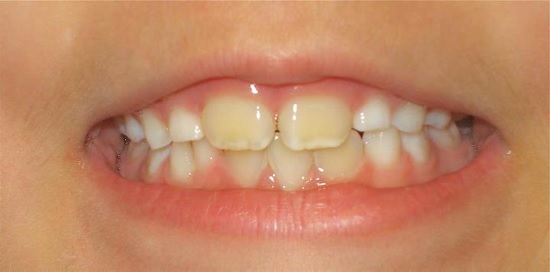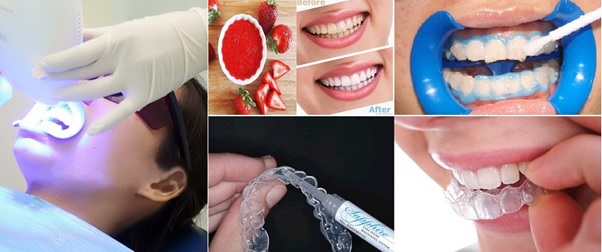Teeth whitening is a method that changes the color of teeth, making them brighter than their original shade. This method is chosen by many clients to improve stained teeth, which often causes a lack of confidence in communication. However, does teeth whitening erode tooth enamel? Does it cause any harm? Before undergoing teeth whitening, you should carefully research this method!
1. Why Do Your Teeth Get Stained?

Teeth can become stained due to various reasons. There are two types of tooth discoloration: surface stains and intrinsic stains (deep within the tooth structure).
Surface tooth discoloration is caused by:
Consuming colored foods and drinks such as chocolate, tea, coffee, soft drinks… which erode tooth enamel, affecting the natural beauty of the entire set of teeth.
Tobacco tar also dulls teeth. Therefore, long-term smokers often experience yellowed, aesthetically unpleasing teeth.
Improper brushing and flossing can also allow food debris and bacteria to accumulate on teeth, making them darker.
Mouthwashes containing Hexetidine can also stain teeth if used for an extended period.
Intrinsic tooth discoloration (within the tooth structure)
Over time, the outer enamel layer of the teeth gradually wears down. Frequent consumption of pigmented foods and drinks will also worsen the condition of stained teeth.
Tooth discoloration can also be genetic, depending on the thickness of the tooth enamel. The thinner the enamel layer, the more visible the yellow dentin underneath. If family members have discolored teeth, you also have a very high risk of yellow teeth.
When Tetracycline antibiotics are used, the active ingredients in the antibiotic diffuse into calcium tissues, causing salts of colored elements to penetrate and stain the teeth. If pregnant women or children under 7-8 years old take this medication, their teeth will change color across the entire arch or in specific areas, with four degrees of discoloration: yellow, brown, gray, and purple.
Using water sources with high fluoride concentrations, using toothpaste with excessive fluoride, or taking fluoride supplements orally are also risks for intrinsic tooth discoloration.
When teeth are stained and an improvement in color is desired, many clients turn to teeth whitening.
To provide clients with comprehensive knowledge and save their search time, we have compiled a detailed article on YELLOWED TEETH. Please check it out!
2. What is Teeth Whitening?

It is a method that uses oxidizing agents (Hydrogen Peroxide) to penetrate the enamel layer. When combined with light energy, Hydrogen Peroxide creates an oxidation reaction that breaks down dark color molecule chains within the dentin, making teeth brighter than their original shade without harming the tooth surface or any internal tooth structures.
3. Is Teeth Whitening Good?

Currently, there are many ways to change tooth color, and teeth whitening is a widely adopted method in Vietnam and many other countries worldwide. This method has been researched and found to be safe for oral health, does not damage tooth enamel, and does not alter tooth structure if performed correctly.
To ensure the safety and best results of the teeth whitening procedure, you should seek a reputable dental clinic that uses genuine whitening agents with clear origins and modern light-assisted teeth whitening systems.
The results of teeth whitening vary from person to person, depending on the cause and initial state of tooth discoloration. After whitening, the brightness may gradually diminish over time, but the tooth color will still be whiter than before.
4. Who Should Not Undergo Teeth Whitening?
Most people can whiten their teeth, except for the following cases:
- Pregnant and breastfeeding women, as the active ingredients in whitening agents may affect the future health of young children.
- Children under 16 years old should also avoid teeth whitening because whitening agents can irritate the pulp, making teeth more sensitive.
- Individuals with periodontal disease, tooth decay, exposed root surfaces… and those who show signs of allergy to teeth whitening agents.
5. Current Teeth Whitening Methods
You can refer to the following two popular teeth whitening methods:
At-home Teeth Whitening Trays:
The dentist will take impressions of your teeth and create a custom whitening tray that fits the size of each person’s teeth.
The whitening tray is made of transparent, safe plastic that does not harm the gums. It holds the whitening agent and prevents saliva from entering, which could affect the whitening process.
This method allows you to manage your time flexibly as it is performed at home with reasonable costs. However, it may not be highly effective for severe tooth discoloration.

In-office Teeth Whitening at the Dental Clinic
The teeth whitening procedure at a dental clinic includes three steps: scaling, polishing, and whitening.
The dentist will combine a whitening agent with a concentration of 35-37% and a high-intensity light beam to activate the solution, allowing it to penetrate deeper.
Before applying the whitening agent, you will be given protective barriers for your lips, gums, and oral cavity, and an desensitizing agent will be applied.
The advantages of this method are that it is performed quickly and is effective even for severe discoloration. Both the upper and lower arches are whitened simultaneously, resulting in naturally even white teeth.

Currently, teeth whitening is widely performed in many dental facilities that lack adequate equipment, or some clients purchase whitening agents to whiten their teeth at home, leading to consequences such as gum burns, pulpitis, etc. Therefore, if you are considering teeth whitening, seek reputable and trustworthy dental centers to achieve optimal and safest results.
Many clients interested in learning about teeth whitening can refer to the article >>> Is Teeth Whitening Harmful?





